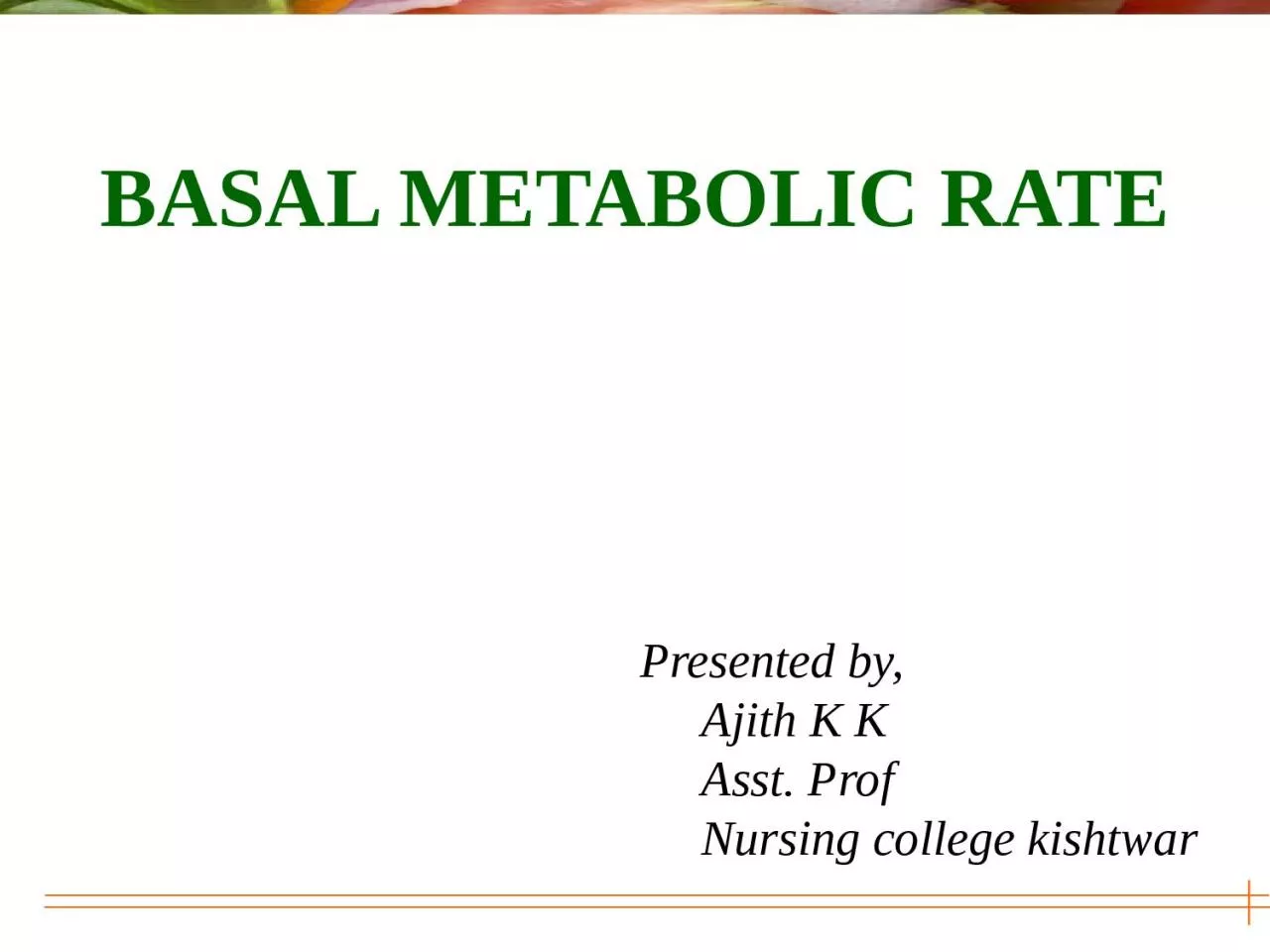

Ajith K K Asst Prof Nursing college kishtwar Energy Energy is the capacity to do work We need energy for Basal Metabolism Basal Metabolic Rate BMR energy required for activity of the internal organs and maintaining of body temperature ID: 1039609
Download Presentation The PPT/PDF document "BASAL METABOLIC RATE Presented by," is the property of its rightful owner. Permission is granted to download and print the materials on this web site for personal, non-commercial use only, and to display it on your personal computer provided you do not modify the materials and that you retain all copyright notices contained in the materials. By downloading content from our website, you accept the terms of this agreement.
1. BASAL METABOLIC RATEPresented by, Ajith K K Asst. Prof Nursing college kishtwar
2. EnergyEnergy is the capacity to do work. We need energy for :Basal MetabolismBasal Metabolic Rate- BMR: energy required for activity of the internal organs and maintaining of body temperature.Physical ActivityMetabolizing of Food
3. Calorie: unit used to measure energyKilocalorie is a unit of energy commonly used to express energy value of food.Food energy is the amount of energy in food that is a available through digestion. The energy value of food indicates its value to the body as fuel.
4. Kilocalories come from foods and beveragesBomb calorimeter used in laboratories to measure kilocalories in foods and beveragesResults must be adjusted for the physiological fuel valuesNutrition analysis software or food composition tables can estimate energy inCarbohydrate and Protein: 4 kcal/gramFat: 9 kcal/gramAlcohol: 7 kcal/gram
5. What Is Energy Balance and Why Is It Important?Energy balance is achieved when the kilocalories consumed equal the kilocalories expended
6. The Concept of Energy Balance
7. The Basal Metabolic RateKeeping your Basal Metabolic Rate (BMR) as high as possible is vital when it comes to weight loss and maintaining healthy body fat levels
8. Factors that Affect Basal Metabolic RateExercise: This is one of the biggest factors that influence BMR. BMR is higher in people who exercise regularly
9. Hormones: an increase in thyroid hormones increases BMR, decreased levels of the hormone lower BMR Body Temperature: Excessive heat or cold raise BMR
10. Gender: Males tend to have higher basal metabolism than females due to an abundance of hormones such as testosterone ad elevated levels of muscle mass compared to femalesAge: as we get older basal metabolic rate becomes increasingly slower.
11. Surface Area: Taller individuals have a higher BMR compared to shorter individuals. More surface area means more heat lost from the body, which causes the metabolism to speed up in order to maintain body temperature.
12. Stress and Illness: increase in hormone activity due to physical or physiological stress increase BMR.Starvation: Fasting for more than 48 hrs. will lead to a decrease of 50% of Basal Metabolic Rate.
13.
14. Health Risks Associated with Body Weight and Body CompositionBeing overweight increases health risksOverweight and obesity associated with increased risk of heart disease, hypertension, stroke, hyperlipidemia, gallstones, sleep apnea, and reproductive problemsIncreases risk of certain cancers including colon, breast, endometrial, and gallbladder cancerMore than 80% of people with type 2 diabetes are overweightMetabolic syndrome is associated with central obesity
15. Health Risks Associated with Body Weight and Body CompositionBeing underweight also increases health risksSymptomatic of malnutrition, substance abuse, or diseaseHigher risk of anemia, osteoporosis and bone fractures, heart irregularities, and amenorrheaCorrelated with depression and anxiety, inability to fight infection, trouble regulating body temperature, decreased muscle strength, and risk of premature deathMay be unintentional and due to malabsorption associated with diseases such as cancer, inflammatory bowel disease, or celiac disease
16.